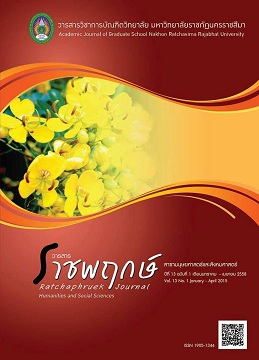A Comparisons of the Learning Management Result Titled of Surface Area and Volume for the Mathematics Learning Substance Group, of the Ninth Students Using the Constructivist Approach, and Mathematics Experimental Project Method and the Conventional Teach
Main Article Content
Abstract
This research aims to 1) compare the pre-post mathematics learning achievement of ninth grade students in titled of surface and volume group substance learning mathematics capacity using constructivist approach and mathematics project method, 2) compare the pre-post mathematic learning achievement Using the Constructivist Approach, and Mathematics Experimental Project Method and The Conventional Teaching Method, 3) compare student’s learning mathematics capacity using constructivist approach and project mathematics method and conventional method 4) compare the student’s attitude in mathematics education who used constructivist approach and project mathematics, project mathematics and conventional methods. The samples were the ninth grade students of Watthuaybong (Borisatkaowthaijamkat) Songkro 3) school in the second semester of the academic year 2012, they were assigned to be in an experimental group, 24 students in Napralan (Piboonsongkro) school, Chaleomprakead District, Saraburi Province were in a control group, 30 students were obtained by using the simple random sampling technique. The research instrument comprised of1) a learning management plan, 2) a mathematical learning achievement test with a reliability value of 0.836, and 3) attitude in building mathematics education value of confidence equals to 0.701. The data analysis was calculated by percentage, mean (), standard deviation (S.D.), and t-test independent.
The findings showed that:
1. The students’ post mathematical learning achievement using constructivist approach and mathematics project method was higher than the pre-achievement with statistical significance at a level of .05.
2. The students’ post mathematical learning achievement using conventional method was higher than the pre-achievement with statistical significance at a level of .05.
3. The students’ post mathematical learning achievement using constructivist approach, and mathematics project method and conventional method was higher than those who were taught using the conventional method in the statistical significance at a level of .05.
4. The students’ attitude in mathematics education using constructivist approach and mathematics project method was higher than those who were taught by using conventional method.
Article Details
References
นิตยา ฉิมวงศ์. (2551). การเปรียบเทียบความสามารถในการคิดอย่างมีวิจารณญาณ และผลสัมฤทธิ์ทางการเรียนกลุ่มสาระการเรียนรู้คณิตศาสตร์ เรื่อง ความน่าจะเป็นของนักเรียนชั้นมัธยมศึกษาปีที่ 3 ที่ได้รับการสอนโดยรูปแบบการเรียนรู้ตามทฤษฎีคอนสตรัคติวิสต์และการสอนตามปกติ. วิทยานิพนธ์การศึกษามหาบัณฑิต สาขาการวิจัยการศึกษา บัณฑิตวิทยาลัย มหาวิทยาลัยมหาสารคาม.
ปรีชา เนาว์เย็นผล. (2551). “การจัดการเรียนรู้คณิตศาสตร์ โดยใช้กิจกรรมโครงงาน”. วารสารคณิตศาสตร์. 52 : 590-592.
ลัดดา ภู่เกียรติ. (2544). การจัดกิจกรรมโครงงานคณิตศาสตร์:โครงการเพื่อการเรียนรู้. กรุงเทพฯ : คณะครุศาสตร์ จุฬาลงกรณ์มหาวิทยาลัย.
สำนักงานเขตพื้นที่การศึกษาสระบุรี เขต 1. (2554). รายงานผลการสอบวัดผลสัมฤทธิ์นักเรียนระดับการศึกษาขั้นพื้นฐาน ปีการศึกษา 2553. สระบุรี : สำนักงานเขตพื้นที่การศึกษาสระบุรี เขต 1.
สำนักงานคณะกรรมการการศึกษาแห่งชาติ. (2542). พระราชบัญญัติการศึกษาแห่งชาติ 2542. กรุงเทพฯ : สำนักนายกรัฐมนตรี.
สุพล วังสินธุ์. (2543). “CIPPA : รูปแบบและการดำเนินการสอนโดยยึดผู้เรียนเป็นศูนย์กลาง.” วารสารข้าราชการครู. 20(3) : 27-37.


